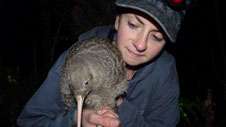Severe inbreeding threatens Long Island's little spotted kiwi

A population of rare little spotted kiwi (LSK) that was thought to be thriving in a Marlborough island sanctuary is actually seriously threatened by the silent effects of inbreeding, new research led by a University of Otago scientist suggests.
Dr Helen Taylor and colleagues analysed the genetic diversity and reproductive success of two LSK populations; one on Long Island in Marlborough that was founded with two birds and one in the Zealandia ecosanctuary in Wellington that was founded with 40 individuals.
Their findings appear in the international journal Molecular Ecology.
LSK, which can live up to 80 years, are the smallest and second rarest kiwi species in New Zealand. There are currently around 1,700 LSK living in 10 populations on various predator-free islands and mainland fenced sanctuaries.
The researchers linked LSK population growth on Long Island to the ongoing breeding success of two LSK birds that were moved to the island in the 1980s; nearly two-thirds of the 50-strong population were found to be direct offspring of this founding pair.
Dr Taylor says that it would normally be expected that the majority of a LSK population founded at that time would mainly be composed of second, third, and fourth generation offspring.
"The overabundance of first-generation birds suggests that the damaging genetic effects of inbreeding are strongly affecting hatching, survival and possibly reproduction of the subsequent generations," she says.
The researchers found poor hatching success in Long Island compared to Zealandia, despite the birds making greater efforts to reproduce. These efforts included more than one egg per clutch and sometimes incubating two clutches per season.
Autopsies of abandoned, unhatched eggs found that many showed no detectable development of an embryo. Embryos that were found in failed eggs were always malformed or wrongly positioned for hatching.
Dr Taylor says the study highlights the pitfalls of using population growth alone as an indicator of the health of a population.
"This LSK population is struggling to grow past the first generation. Once the original pair of kiwi die or become too old to breed, the population will likely go into decline," she says.
Dr Taylor says the findings have implications for other populations of threatened species founded with a small number of individuals, especially in long-lived species.
"Our research highlights the importance of collecting many kinds of data to measure population viability and conservation success - not just population growth. Just because a population appears to be growing does mean it is secure in the long term. We could never have worked out what was happening in the little spotted kiwi on Long Island without genetic data," she says.
Previous work by Dr Kristina Ramstad at Victoria University of Wellington showed that LSK have extremely low genetic variation as a species, with all 1,700 existing birds being descended from just five birds that were moved to Kapiti Island in the early 1900s. The 10 populations of LSK are currently managed by DOC as one large metapopulation, with birds being moved between populations to minimise loss of genetic diversity. A genetic rescue attempt, bringing new birds into the Long Island population from one of the other populations, could potentially boost genetic diversity and reduce inbreeding.
Journal information: Molecular Ecology
Provided by University of Otago




















